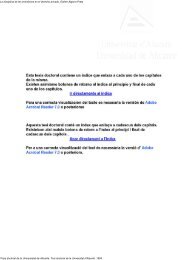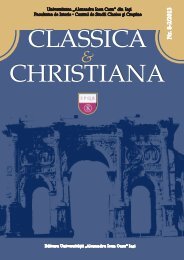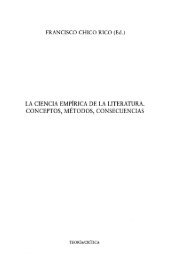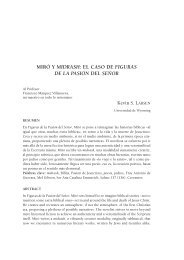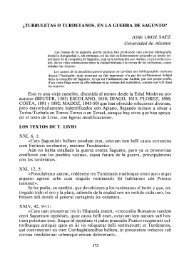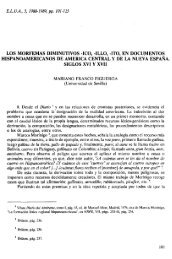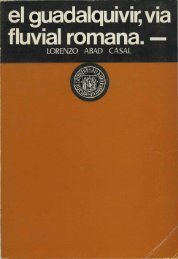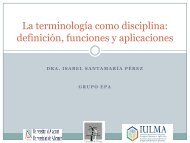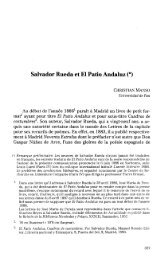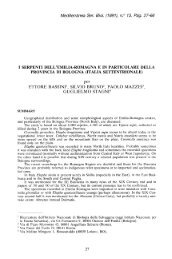goethean rhymes and rhythms in verse translations of faust ... - RUA
goethean rhymes and rhythms in verse translations of faust ... - RUA
goethean rhymes and rhythms in verse translations of faust ... - RUA
You also want an ePaper? Increase the reach of your titles
YUMPU automatically turns print PDFs into web optimized ePapers that Google loves.
Goethean Rhymes <strong>and</strong> Rhythms <strong>in</strong> Verse Translations <strong>of</strong> Faust <strong>in</strong>to Spanish<br />
7trans<br />
<strong>of</strong> 'curl<strong>in</strong>g' is added by means <strong>of</strong> the verb rizáis. Rizar technically decribes the same activity as<br />
kräuseln, but after all, rizar virutas does not correspond to Schnitzel kräuseln <strong>in</strong> German,<br />
because an idea <strong>of</strong> carpentry is evoked, not one <strong>of</strong> paper slips curled to make baroque wigs.<br />
Cans<strong>in</strong>os (1957: 1: 365) possibly noticed the <strong>in</strong>congruity <strong>and</strong> decided to expla<strong>in</strong> the “obscure<br />
metaphor” <strong>in</strong> a large footnote. José María Valverde (1963: 20) obviously used Cans<strong>in</strong>os's<br />
translation as a model, but he condensed the idea to the po<strong>in</strong>t <strong>of</strong> <strong>in</strong>comprehensibility <strong>in</strong> order to<br />
reduce the number <strong>of</strong> syllables for his endecasílabo <strong>verse</strong>:<br />
en que a la Humanidad sacas virutas [...]<br />
José María Valverde uses endecasílabos even for passages for which Goethe employs rather<br />
short <strong>verse</strong>s, for example <strong>in</strong> the song <strong>of</strong> the Earth Spirit. In the first “Night” scene, the Erdgeist<br />
reveals to Faust that his activity consists <strong>in</strong> giv<strong>in</strong>g rise to the cycle <strong>of</strong> life <strong>and</strong> all activity on<br />
earth. The Earth Spirit s<strong>in</strong>gs <strong>in</strong> trochees <strong>and</strong> iambs, which create a very agitated rhythm evok<strong>in</strong>g<br />
the movements <strong>of</strong> the Spirit, first <strong>in</strong> crossed rhyme <strong>and</strong> then <strong>in</strong> couplets (Faust, vv. 501-503).<br />
In Lebensfluten, im Tatensturm<br />
Wall' ich auf und ab,<br />
Wehe h<strong>in</strong> und her!<br />
As Valverde (1963: 19) does not recreate the playful <strong>rhythms</strong> <strong>of</strong> the Earth Spirit's <strong>verse</strong>s, the<br />
Spanish version does not evoke the Erdgeist's activity metrically. What is more, the<br />
enjambement used by Valverde further levels out the orig<strong>in</strong>al rhythm <strong>of</strong> the passage.<br />
En rebose de vida, en tempestad<br />
de acción, yo subo y bajo en oleadas,<br />
y me agito de un lado para otro.<br />
On the other h<strong>and</strong>, Valverde regularly imitates Goethe's iambs through the use <strong>of</strong> endecasílabos<br />
heroicos (cf. T. Navarro 1959: 51), whose regular trochaic feet sound like blank <strong>verse</strong>. For<br />
example <strong>in</strong> the scene with the student, Mephistopheles ironically observes that when study<strong>in</strong>g<br />
metaphysics one has to fathom ideas which “won't fit the human bra<strong>in</strong>” (Faust, vv. 1951-1952):<br />
Da seht daß ihr tiefs<strong>in</strong>nig faßt,<br />
Was <strong>in</strong> des Menschen Hirn nicht paßt.<br />
Not only is the translation almost literal, the regular iambic feet are rendered by José María<br />
Valverde (1963: 56) as endecasílabos heroicos, which have a similar rhythm as the<br />
correspond<strong>in</strong>g <strong>verse</strong>s <strong>in</strong> German:<br />
Veréis cómo captáis con honda mente<br />
lo que en cabeza humana nunca cabe.<br />
This imitation <strong>of</strong> blank <strong>verse</strong> through endecasílabos heroicos can be found so <strong>of</strong>ten <strong>in</strong><br />
Valverde's Faust that I assume it is <strong>in</strong>tentional. Not only Valverde, also Norberto Silvetti Paz<br />
uses “iambic feet” <strong>in</strong> this manner <strong>in</strong> his Faust, <strong>and</strong> most likely he even announces it <strong>in</strong> his<br />
<strong>in</strong>troduction, where he mentions us<strong>in</strong>g “el verso blanco” (Silvetti Paz 1970: 24). In Spanish this<br />
usually refers to unrhymed <strong>verse</strong>, however, given the recurrence <strong>of</strong> such “iambic” <strong>verse</strong>s, I<br />
consider he had the German expression <strong>in</strong> m<strong>in</strong>d, too. In “Walpurgis Night” I found an example<br />
<strong>of</strong> such a “blank <strong>verse</strong>”, when Faust exclaims, on see<strong>in</strong>g the multitude <strong>of</strong> witches <strong>and</strong> wizards<br />
ascend<strong>in</strong>g the Broken (Faust, v. 4115):<br />
Heiß' ich mir das doch e<strong>in</strong>e Messe!<br />
The rhythm <strong>of</strong> Silvetti's (1970: 357) version resembles that <strong>of</strong> the orig<strong>in</strong>al here:<br />
MonTI 5trans (2013). ISSN 1889-4178



